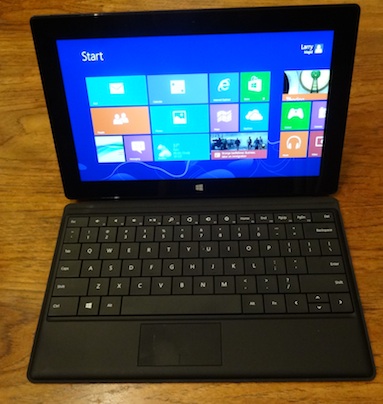
I was pretty excited when the Surface Pro arrived about ten days ago, so I could test it ahead of its release on February 9th. Finally, a tablet that’s also a laptop that also runs a mature operating system (Windows 8) and lets me use all the PC software I know and love. This is the machine I’ve been waiting for.
After more than a week of using it, I appreciate its strengths but I’m less excited because I can see its warts along with its good points
The Good
First the good stuff. It really is a full-blown Windows PC. Every program I tested it with worked out of the box. After using iPads, Android tablets, Chrome laptops and even Microsoft’s own Surface RT, it was a welcome relief to be able to install and use my favorite Windows programs. For example, I use Audacity to record my radio segments on my desktop PC and my MacBook Air laptop, and the program worked great on the Surface Pro. I was also able to use the same USB microphone I use on my regular laptop. After trying to use apps to record professional audio on iPads and Android tablets it was nice to be able to do it easily on the Surface Pro using tools I already know and love.
I also like that it’s reasonably small and light. With the optional Type cover (that sort of turns into a laptop), it weighs 2.53 pounds — slightly heavier than the 2.38 pound, 11-inch MacBook Air. I also like that it’s two devices in one. Windows Surface owners don’t have to carry around a separate tablet because their computer is their tablet and their tablet is their computer. It also has a great screen and comes with a digitizer pen that allows you to do precision work without giving up the ability to use your fingers as you would with an iPad or Android tablet.
I’ve grown to like the Windows 8 operating system when running on a touchscreen device like the Surface Pro. I am not a fan of Windows 8 for older machines that don’t have touchscreens but it’s a great operating system for touchscreen laptops and tablets. When I go back to using my MacBook Air, I keep finding myself reaching for the screen, as if it would actually respond to my touch.
I also found that the machine is peppy and responsive in almost every way, but there is one but that I’ll get to in a moment.
The Surface Pro supports two optional keyboards from Microsoft that also dub as covers. There is $119.99 “Touch” cover/keyboard which is really designed for people who don’t do much typing and there is the $129.99 Type cover that Microsoft bills as having “mechanical keys for rapid typing.”
Keyboard disappointment
Both keyboards are thin and light but the Type keyboard has the same key spacing as a standard desktop and laptop keyboards. That came as a surprise to me for two reasons. First, because it looks smaller and second is because when I type on it I find myself making more mistakes than I usually make with a full-size keyboard. I just assumed it was about 10% smaller but when I measured it, I found out it was the same size.
I’m not sure why this is happening but I find that I can actually out-type the keyboard. Yes, I’m a fast typist but any computer should be able to keep up with any typist. It could be that I’m hitting two keys at once or maybe touching the touchpad with my wrist as I type (it’s hard to observe my own fingers as I type close to 100 words a minute) but whatever it is, I find it keeps happening even after a few days of using the machine. To make sure it was the keyboard not the machine itself, I plugged in a desktop USB keyboard and it worked fine. I also tried a second Touch keyboard and got the same not-so-great results. I’m hoping that Microsoft improves the keyboard or third parties create optional keyboards for the device that don’t have this problem.
The other thing that keeps this from being a full laptop replacement is that the keyboard is not rigidly attached. The magnetic attachment works fine and there is a kickstand for the screen that lets you place it so it works like a laptop when you’re at a table or a desk, but it’s hard to use the Surface Pro – literally – as a laptop since the screen keeps flopping over if you hold it on your lap or you try to use it lying down (which I admit I sometimes do).
As a tablet, it works well, although at 2 pounds without a physical keyboard, it’s heavier than the 1.44 pound iPad with Retina display. I like Microsoft’s onscreen keyboard and agree that the Windows 8 tiles interface works well for a touchscreen tablet.
While there will be some people who will be able to use the Surface Pro as a laptop replacement, I’m not one of them – at least until the resolve my keyboard issues. The Surface Pro starts at $899. For details, visit Surface.com.